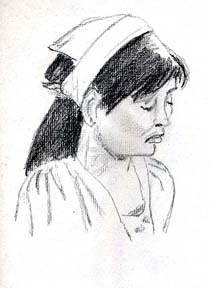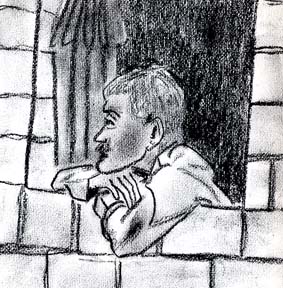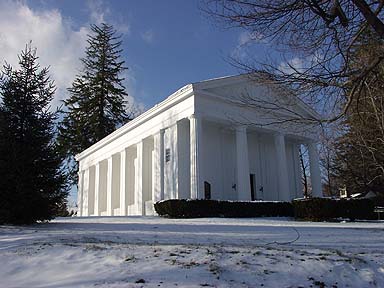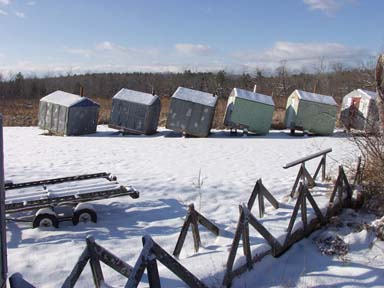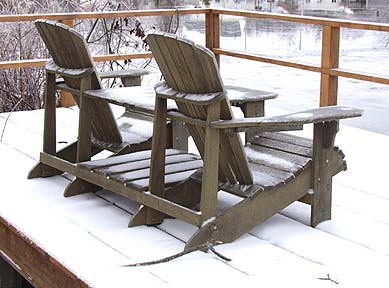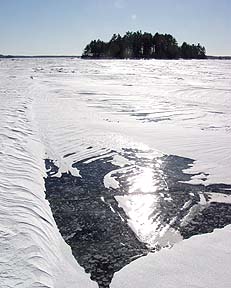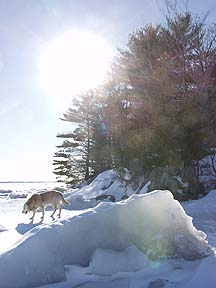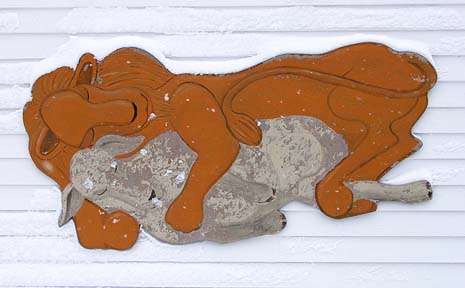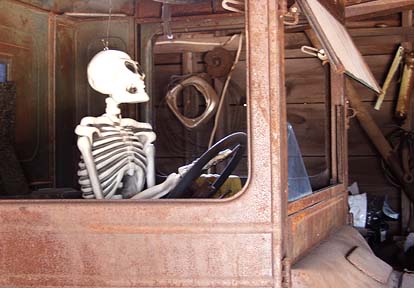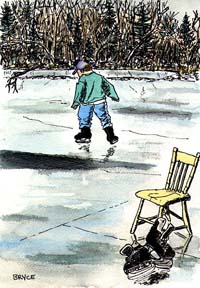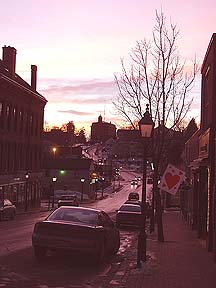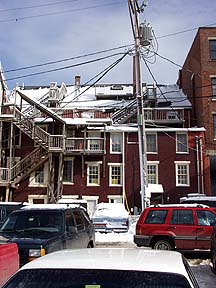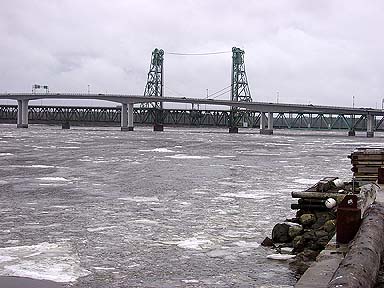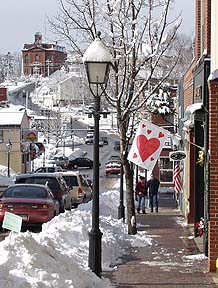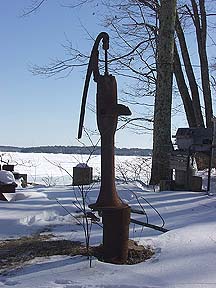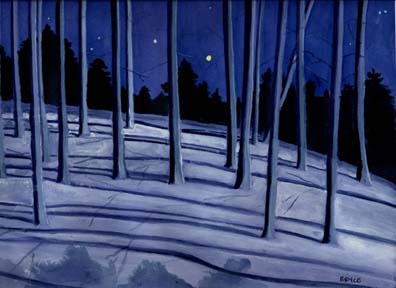Sagadahoc Stories 137: 2/23/05
Art in Winter
I takes a while to get acclimated to winter, or a political defeat. The chill gets to you at first, then you get used to layering up to insulate yourself. Finally you begin to take joy in the biting cold. Winter tries to crush you, but in the end it invigorates. Or so I’d like to analogize. It’s been crushing cold in the gallery this season. Not the air temp. Ray and Roy keep the heat salubrious. But there’s been a deathly stillness, and the faint laughing of ravens. Any illusions about mobs stopping in to share visions, or look at mine, have long since flown south. |
| Gallery Muir is a nice bright sunny space to draw and paint and sand in, though, or to work on my piano playing. So I’ve been happily productive there. And we’re still trying on new schemes to use the space. We invested in a digital projector which can throw images from DVDs, VCRs, or a laptop onto the wall, and have been screening movies in the back room between exhibitions. Every first and third Friday of the month Gallery Muir becomes a flick palace. And I often have an arty film running to animate the back room. |
| One Saturday we made a dandy discovery. This projection device can pause
and zoom in on images in the movies. Peggy and I spent four hours drawing
people in the film “Baraka,” and the ability to freeze-frame
human motion to render it is thrilling. Peggy says there is an archive
of dance videos from the Bates Dance Festival, and perhaps we can finally
draw those fabulous dancers. Not to mention all the faces and figures
in rental flicks. Instant drawing class. |
| So we continue to evolve the Gallery as a work of art, or at least a place of art. And that’s what I’d like to muse on in the crispness of February. What are art places? What is the role of a gallery in the provinces? What can art do to lessen the chill? |
| One thing art does for me is it takes me out of myself, or more deeply into myself. Or both. Either way the art experience transcends my individual here and now. Nature and other phenom can do that, too, of course. There’s nothing like a good moonrise to help you forget the daily news. Or the excitement of a crowd can put paid to your private dues. But the transcendent effect of experiencing a made work, someone’s creation, has the extra charge of a personal sharing. Sharing a gift. When a piece of your artwork moves me beyond myself, or deeper into myself, that’s a gift from you to me. And my perception of it is a gift in return. |
| But galleries rarely have the feeling of a gift exchange. They appear to be art stores. Tire-kickers come and go, ho-humming at the work on display, collectors listen to dealer hype and weigh resale value, shoppers look for decorative items. Gallery owners are looking for customers, or, at best, patrons. Prices are intimidating, and meant to be. Galleries are part of the upscale marketplace, not part of a circle of giving. |
| Must it be that way? There’s the material necessity of cashflow, certainly. I’ve priced my work in our gallery at a subsistence level. If anyone buys it, that will pay the rent and a living wage to me. The gift of a livelihood in return for my creations. A fair trade, I think, and a mutual giving. Even so, my prices are way above what most folks in Bath would dream of paying. And merely being in an art gallery is intimidating to your average Joe. Only a rare few buy art. Why else would you go into a gallery? |
| Well, I go into galleries to experience the work. To share the gift of creative vision. But even I am intimidated by the sacral hush, the pretentious presentations, the breathless explanatory texts, and the breath-taking prices, in most galleries. I see the staff looking askance at my shoes. And I feel like the rube I am. |
Gallery Muir is more low key. Too much so, I’ve
been told by gallery aficionados. A few spot-lit works. More monumental
sculpture. A more august air, might lure in the right customers, I’m
told. I think those with eyes to see, and a kindred spirit, will encounter
the work without genuflection. But maybe I’m wrong. |
| Some have, certainly. And the conversation has opened out into the symbolic content of the work. But it still feels more like preaching than communion. I give these images to the passing eye. A few see what’s in them – in the work, and its echo in themselves. But where’s the artistic dialogue? Even if someone buys a piece (the highest recognition of mutual understanding), it is more of a material transaction than a metaphysical one. I give a vision to the world, and get paid cash (on the good days). |
| Isn’t that curious? If art speaks to an inner consciousness, shouldn’t artists expect some psycho-spiritual feedback? If I blow flute in an ensemble jam the other musicians converse with me at the same level – when we’re in the groove. Even the audience dances, or taps its foot. There’s precious little foot-tapping in a gallery. |
| I’ve had one woman bring in her artwork to show me, in response
to what she saw in the gallery. One. (We’ll be having a show of
her work next month.) I find that very strange. Where is the creative
conversation? Are artists all living and working in isolation, hiding
their work, only interested in exposure for the sake of big sales and
kudos? |
| I know self-important artists for whom Gallery Muir is beneath contempt. A small provincial gallery showing déclassé folk art and pretending to call it ART. How sad that they can’t see over their walls to view my terrain. Any creative work outside their self-imposed boundaries doesn’t exist. |
| Art, when it works for me, is transcendent. It also teaches me to see differently. Another artist’s rendition of the world, inner and/or outer, lets me see through his eyes. Teaches my eyes to see the world anew. I find this exhilarating. Carlo’s extravagant colors open up my palette of perception. Tom Crotty’s photo realism reminds me of the transcendent in the mundane. A child’s drawing on the fridge shows me the forces in her world. |
| It’s absurd to single out a few artists in each generation and say only their work is worth looking at. What speaks to me may not speak to you. We need all kinds of art to re-see the world, and renew ourselves. The only way to change the world is to change how we see it. |
| In the 19th century the southern Maine landscape was seen as farmland, and all the trees were logged off. In the 20th the great north woods were seen as a paper plantation, just so much fiber. The result was clearcuts. Now many people envision Maine as a nature preserve, and they see the landscape differently. They object to the powerlines in my drawings because such stuff breaks the spell. I have a vision of man IN nature, not opposed to it. Manscape in landscape. Technology in the woods. So I see the power poles. My cartoon landscapes speak my perceptions. Often I don’t know how I see until I’ve drawn it. Shouldn’t we be trying to pool our perceptions by sharing our artwork? |
| We need to look at all kinds of art to know how we all see the present. Instead, we’ve been conned by one side of the American Myth: exalted individualism. We worship the Lone Artist, riding off into the sunset with his special knowledge. Artists are expected to be idiosyncratic, unique visionaries, gunslingers. Not only should they be social isolates, the commercial imperative says they must butt heads until El Toro, the one great artist of the day, stands triumphant in a New York gallery. What tripe. |
| While there’s no doubt artists have to cultivate their egos to survive in a commercial world, they hardly need buy into the hierarchical hype which pits them against one another. Yes, in each generation certain artists have changed how we view the world. Art history defines them as “great.” As though “first” was always “best.” Not to deride their inspired insight, but we need the work of all our artists, today and every day, to enlarge our vision. We don’t need a few chosen artists whose work is sold in a rarified market or cloistered in museums. We need everyone to look more closely at the world, and that means more artists, more art, and more access. |
| Our understanding of the world, and of ourselves in the world, is filtered through our perceptions. The only mirror of our perceptions is how we render the world in our creative expressions. We don’t know how we see the world until an artist shows us. Old ruins weren’t romantic until painters painted them that way. The American landscape wasn’t majestic until the Hudson River School taught us to see it that way. The insufferable sentimentality of the American booboisee was never so obvious until Kincaid sold his visions to them. What do Christo’s gates tell us about how we see the urban manscape? |
Maybe painters and carvers are the last individual
artists, and they should keep their distance. Maybe the necessarily
collaborative art of architects, moviemakers, and Christos, is the community
art of our gilded age. But I still yearn for a world of local artists
who speak to one another in art, evolving a local vision the way a jazz
ensemble passes the changes around. I guess I just want to see what
my creative neighbors are up to. Glimpse how they see this place. |
There are some art collaboratives. Artists draw together. The Union of Maine Visual Artists dies and is reborn each decade. I’m not really looking for a fraternal organization, or a Guild of Artists to join, though. I’m looking for a shared sensibility: that we are all in this together. |
That’s where my moaning for an artistic vision and my politics come together. The same bill of goods we buy as artists -- that it’s a dog-eat-dog world, and only a few “important” artists are worth looking at (and buying) -- is the same doctrine we hear preached about the invisible hand of the Holy Market. Self-interest results in the common good, we’re told. This is a Taker’s theology. Winner takes all, and then dispenses (faith-based) charity to the losers. |
| I prefer a political paradigm which says all of our ways of seeing the world combine to give us a whole vision. That life is a circle of giving where we can share our individual gifts. Where my creative gifts can open your eyes, and yours mine. I don’t know if we can help restore a Giver’s paradigm in an art gallery. But, if artists don’t get off their high horses and try to see together, who is going to show us a new vision? |
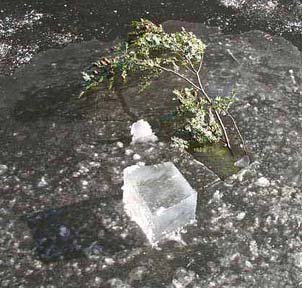
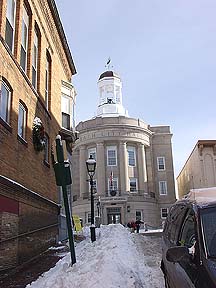
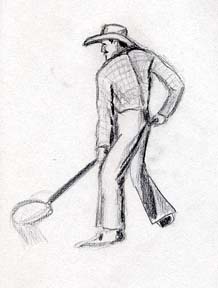
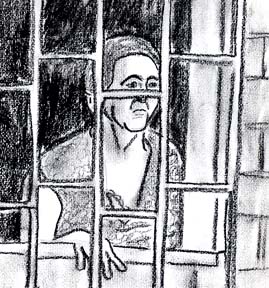
 Blue
Shadow
Blue
Shadow 